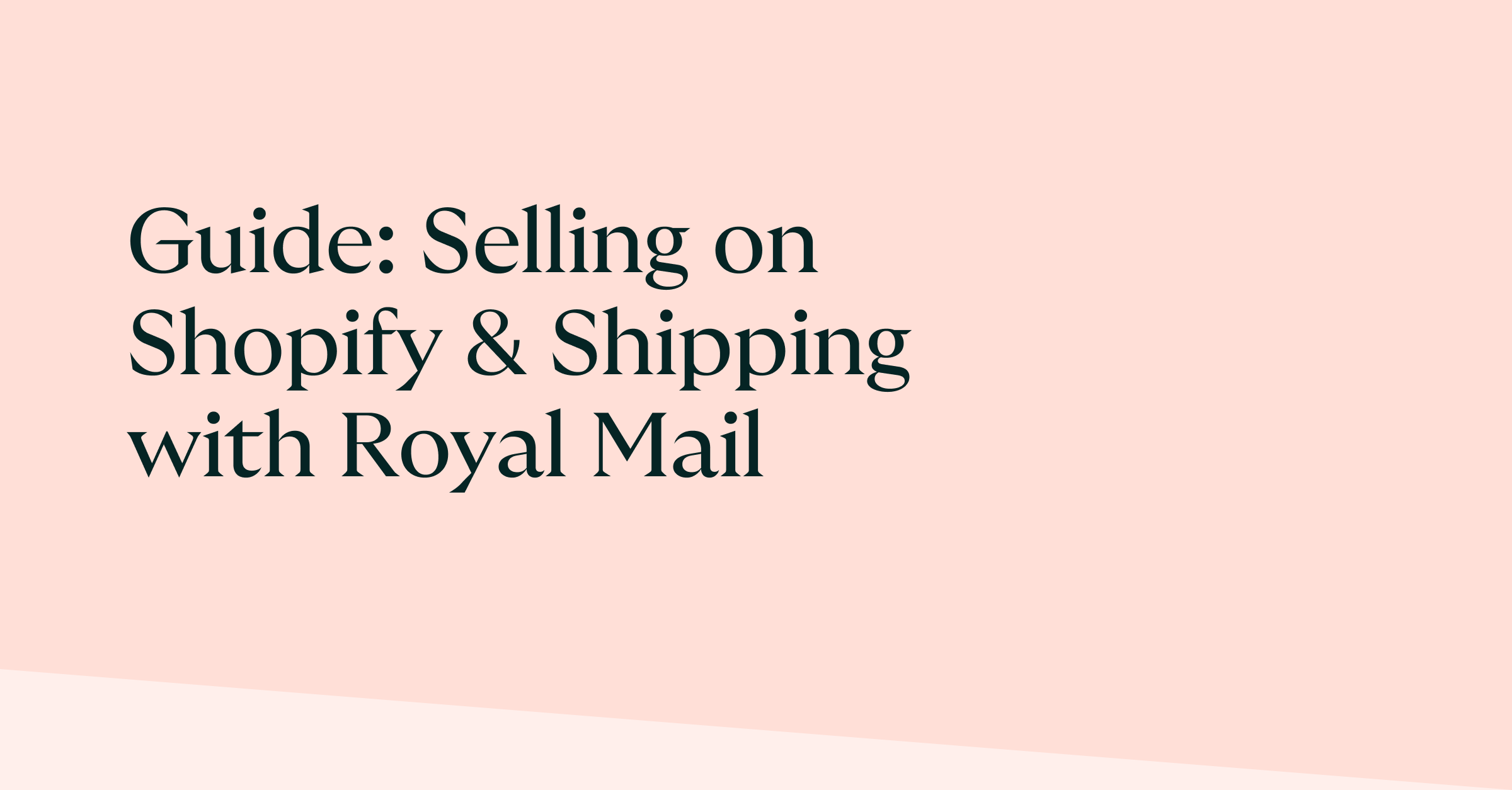Shipping is a critical part of running a successful Shopify store. Delivery is a huge part of your customers’ buying experience, and poor delivery is the number one reason shoppers don’t buy from a brand again.
Shopify is the leading ecommerce platform, and Royal Mail - with its trusted reputation, range of services and competitive pricing - is one of the UK’s most popular shipping options.
But as your order volume grows, the shipping setup that once “did the job” can quickly start holding you back. Slow-downs, manual processes, orders falling through the cracks, or a lack of visibility can all creep in just when things are getting busy, especially around peak season.
In this post, we’ll break down the three stages of shipping with Royal Mail when selling on Shopify – from start-up to scaling – and explain when (and why) it’s time to level up.
Stage 1: Shopify Shipping
Perfect for start-ups and new sellers.
Shopify Shipping is a fantastic way to start shipping with Royal Mail. You can print shipping labels directly from Shopify and drop orders off at your local post office. It’s simple, fast to set up and cost-effective - ideal when you’re finding your feet.
Pros of Shopify Shipping:
✅ Very easy to set up and use
✅ Perfect for testing the waters with small volumes
✅ Low cost and minimal tech requirements
✅ Competitive pricing for start-ups without a Royal Mail OBA
✅ Works with thermal and A4 printers
Cons of Shopify Shipping:
❌ Manual label printing for each order can be time-consuming
❌ Access to a handful of Royal Mail services
❌ Trips to the post office quickly add up as volumes grow
❌ No direct human support when things go wrong
❌ Accessing key print/pack documents often requires extra apps
When do businesses upgrade from Shopify Shipping?
Businesses often move on when they start shipping 20+ orders per day, when manual tasks start eating into selling time, or they hire a member of staff to help with fulfilling orders.
Stage 2: Click & Drop
Ideal for growing businesses shipping up to 50 orders per day with Royal Mail.
Click & Drop makes it simple to generate Royal Mail labels, and supports both PAYG and OBA accounts. This allows you to access more services, bespoke rates as well as the option to book collections and print manifests. A big step up from manually dropping parcels at the Post Office.
It’s great for brands gaining traction who are shipping exclusively with Royal Mail and want a bit more control over process, and are looking to achieve efficiency improvements.
Pros of Click & Drop:
✅ Book collections and print manifests – no more daily Post Office runs
✅ Solid platform with basic automation features
✅ Print pick/pack documents to streamline fulfilment
✅ Easier to manage multiple orders than Shopify Shipping alone
✅ Integrate your own Royal Mail OBA for better pricing and more services
Cons of Click & Drop:
❌ Still requires manual steps to ship orders
❌ Room for error; harder to train new staff
❌ Shopify sync is one-way – order changes (like address edits) don’t update
❌ Can become cumbersome as order volumes rise
❌ Human support is limited if things go wrong
When do businesses upgrade from Click & Drop?
Most brands start to feel Click & Drop’s limits when they’re regularly shipping 50+ orders per day, have complex fulfilment needs, or use multiple carriers.
That’s when we often hear:
“It’s fine for now… but it’s slowing us down.”
If that sounds familiar, you’re not alone – most fast-growing Shopify stores hit this point sooner than they expect.
Stage 3: Shipping Software (e.g. Zenstores)
For businesses ready to scale – typically shipping 50+ orders per day.
This is where things level up. Shipping software, such as Zenstores, automates your entire shipping workflow, from the rates shown at checkout to shipping service selection, label generation, and dispatch.
With an approved Royal Mail partner like Zenstores, your OBA is fully supported and integrated. Even setup is handled for you - so you won’t skip a beat.
As your volumes grow, this kind of automation stops fulfilment from becoming a bottleneck and helps your team build reliable, scalable processes.
Pros of Shipping Software:
✅ Full automation reduces manual work and errors
✅ Real-time sync with Shopify – always up to date
✅ Easier teamwork and training as processes are centralised
✅ Seamlessly add other carriers alongside Royal Mail
✅ Reliable, robust and scalable as you grow
✅ Expert support via phone, email, and live chat
Cons of Shipping Software:
❌ Monthly subscription cost
❌ Requires setup and configuration (though Zenstores handles most of this)
❌ Can be overkill for small sellers shipping under 50 orders/day
Zenstores is for when it’s time to move on from “it’ll do for now”
At Zenstores, we make switching painless - because slowdown, or even downtime, in the warehouse causes strain in the team, support tickets and bad reviews. We’ll handle setup, training, and your Royal Mail integration, so you can focus on maximising sales, not fixing fulfilment.
Shipping doesn’t have to be a bottleneck for your Shopify store. By matching your setup to your order volume now and where you plan to be – and levelling up when the time’s right – you can save time, reduce errors, and keep your customers happy while scaling smoothly.
If you’re ready to take your shipping to the next level, Zenstores can automate your Royal Mail orders, manage multiple carriers, and keep your business running smoothly, even through peak. Get the Zenstores Shopify App here.


